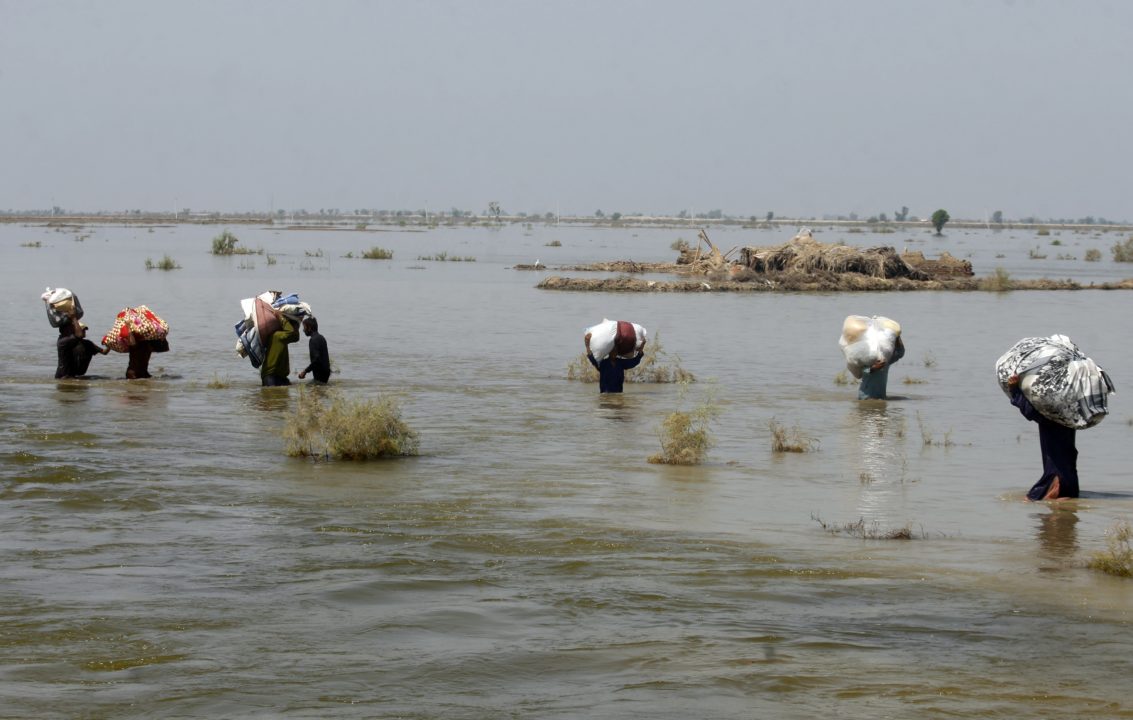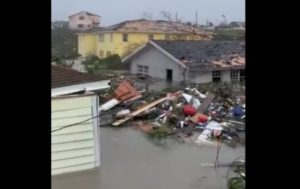Karachi Dispatch: After the Deluge
Relief efforts begin after devastating flooding in Pakistan. Victims of heavy flooding from monsoon rains carry relief aid through flood water in the Qambar Shahdadkot district of Sindh Province, Pakistan, Sept. 9, 2022. Scientists have said climate change no doubt helped swell monsoon rains this summer that dumped three and a half times the normal amount of rain, putting a third of Pakistan underwater. Photo: AP / Fareed Khan
Victims of heavy flooding from monsoon rains carry relief aid through flood water in the Qambar Shahdadkot district of Sindh Province, Pakistan, Sept. 9, 2022. Scientists have said climate change no doubt helped swell monsoon rains this summer that dumped three and a half times the normal amount of rain, putting a third of Pakistan underwater. Photo: AP / Fareed Khan
Truthdig is proud to present this article as part of Global Voices: Truthdig Women Reporting, a series from a network of female correspondents around the world who are dedicated to pursuing truth within their countries.
KARACHI, PAKISTAN October 13, 2022 — In August and September, the southern Pakistani regions of Sindh and Balochistan received extraordinarily heavy rains following an unusually hot summer. Soon thereafter came devastating floods, caused by the rains and also the accelerating melting of the glaciers in the country’s mountainous northern areas of Gilgit-Baltistan and Khyber Pakhtunkhwa.
The full magnitude of the disaster is still being assessed, but what we already know is stunning: nearly a third of the country was submerged, with more than 1,600 people and thousands of livestock swept away to a watery grave. At least 12,000 people suffered injuries. The national infrastructure, including dozens of major roads and bridges, was severely damaged.
All told, nearly 33 million people, including 16 million children, have been affected, with many of them joining the ranks of the Internally Displaced Persons (IDPs), a growing category that covers those made homeless by the ravages of armed conflict and climate change. It does not augur well for the future of Pakistan that the newly displaced are poverty-stricken. Overwhelmed by the tragedy, they have little understanding of what happened or why. When rescuers speak to them, most simply note how heavy the rains were and how the floods took them by surprise. “We were sleeping and woke up when we found ourselves covered with water in our beds,” a survivor said in the Sukkur district. “We somehow managed to scramble to the rooftop and save our lives. Others were not so lucky.”
The flood submerged much of the country, but it surfaced the defining paradox of Pakistani society: a generous people who stepped in to fill the void left by a government unable to respond to the calamity.
Many who lost their homes accept their taqdeer (fate) with quiet resignation. The more knowledgeable among the public express awareness of the phenomenon of climate change. They know from the media that the climate is causing heavier monsoons and shrinking the glaciers. The educated now also know how human errors have made the crisis worse. They are aware of the skew of responsibility: While the U.S., China, Russia and Canada account for more than half of global CO2 emissions, Pakistan’s share in it equals less than 1%.
The flood submerged much of the country, but it surfaced the defining paradox of Pakistani society: a generous people who stepped in to fill the void left by a government unable to respond to the calamity. In Sindh, the worst affected region, the flooding was compounded by years of bad planning and corruption. When the River Indus overflowed its embankments, its impact on 18 of the 23 districts of rural Sindh was severe due to the absence of drainage and land reclamation schemes in the deltaic area. Because of this, it will take a couple of months for the floodwaters to evaporate and allow the displaced persons to return to their villages and start rebuilding their homes. For that, they need funds that they do not have. To pump the water poses a challenge for the government agencies. The water is trapped in the pockets created by the road network and an attempt to dewater one area would unavoidably flood the neighbouring farms. That would risk, for the authorities, the anger of those affected.
The provision of emergency food and shelter remains an ongoing failure, a month after the flooding. Full rehabilitation will take time, but at the moment it is civil society that is mobilizing to distribute rations, cooked food and tents to help the flood-stricken. Donations have poured in, and Pakistanis with resources have gone all out to ease the sufferings of their less fortunate compatriots.
Sadiqa Salahuddin, executive director of the Indus Resource Center (IRC), captures the best that Pakistan has to offer in her description of these efforts. “The relief kitchen cooks and their teams arrive early in the morning to take their positions in the supply chain,” she says. “The relief kitchen is the most labor-intensive and time-taking activity at IRC’s office in Khairpur. The cooks and their teams start arriving early in the morning to take their positions in the supply chain. The food gets ready around 1 o’clock. Three to four teams take it in different directions. At the destination camp, they lay a ‘dastarkhwan’ (tablecloth). Women and children are served food first. The men’s turn comes later. In each location, 200 to 400 persons have their meal every day. IRC is extremely thankful to the Relief Kitchen team who try their best to reach out to quite inaccessible communities — one is accessible only by boat.”
Reports of the government’s role in the relief operations are mixed. While there have been some positive accounts of the administration distributing food and tents, others have reported a general lack of trust in the state functionaries. There have been cases of private organizations rejecting the government’s offer of lending its bigger manpower for distributing relief goods. This is not unexpected given the media shots showing foreign relief goods hoarded in godowns and being sold in the market. Petitions have been filed in courts to ensure accountability, leading to delays and, at times, mismanagement since relief work is a skill in itself. Those adept at it observe the guidelines laid down in the Sphere’s Handbook scrupulously and show compassion and dignity to the survivors.
Women have assumed leadership roles across all spheres of the relief effort. I talked to Naween Mangi, managing trustee of the Ali Hasan Mangi Memorial Trust (AHMMT) that operates in the region of Kheiro Dero. Always upbeat, Mangi sounds despondent this time. Nearly 60% of the houses her organization had helped to build were damaged or destroyed. She works 15 hours a day providing shelter, food, cash transfers for rations, medical assistance, tents and mosquito nets to thousands of people.
At the same time, there is no shortage of misogyny on display by those who resent women entering public spaces, especially in the development sector. Recently, a group of men attacked Mangi’s community center with firearms, without provocation. The police came to her rescue, and she rededicated herself to changing mindsets in her village, in Sindh district, and in Pakistan as a whole. She has begun to make an impact, too, winning the confidence of her people and persuading more women to join her team.
As it confronts the homelessness caused by the floods, Pakistan also faces a public health emergency. Outbreaks of malaria, dengue and skin ailments have brought the medical community to the flood-hit areas where stagnant water serves as breeding grounds for mosquitoes, and an absence of clean drinking water risks diarrhea, typhoid and cholera. While no statistical data are available for diseases, Dr. Shershah Syed, a celebrated gynecologist known for his services to fistula sufferers all over the country, estimates that flood-stricken include 75,000 pregnant women at risk. He has opened the doors of his women’s hospital in Koohi Goth to any woman needing care.
What Might We Do?- Several local organizations have been providing aid to flood survivors. Our reporter recommends the following:
- The SIUT is working to provide health care to those in the affected areas. Visit their website at https://siutna.org.
- Indus Resource Centre normally runs schools but lately has also been doing relief work, as its priority shifted to saving lives. It will need funds for rebuilding its schools. To help, contact [email protected].
- The Ali Hasan Mangi Memorial Trust works for overall development, which includes housing, health, education and livelihood. It has been doing relief work during the floods and is turning to rebuilding houses. Visit their website at www.alihasanmangitrust.org.
The floods have resulted in a magnanimous show of volunteerism from Pakistan’s medical community. One doctor working in Sukkur with the Sindh Institute of Urology and Transplantation (SIUT) told me that his team sees as many as 800 patients a day in his hospital. Practically everyone is ill. The SIUT has set up 37 medical camps — 33 in Sindh. Other health institutions have also dispatched medical teams or set up medical camps, most under the umbrella of the Pakistan Medical Association or various private hospitals.
The larger pharmaceutical companies have donated drugs for medical camps, but some small retailers have tried to profit from the crisis. The humble painkiller Paracetamol has all but disappeared from the markets and is being sold at exorbitant prices in affected regions.
The flooding catastrophe hit an indebted Pakistan while in the grip of a serious economic crisis. For decades, corrupt and inept governments have borrowed with abandon from the West, from China, from big oil producers and from the international aid agencies and institutions. No serious efforts have been made, however, to industrialize the country and boost its exports to reduce its balance-of-payments deficit. When the time arrives for repayment of its International Monetary Fund loans, Pakistan’s economy will again be on the verge of default. The $30 billion in flood losses are a heavy blow to Pakistan, raising the prospect of an economic recession — a third emergency. With the rice and wheat crops in Sindh destroyed by the flood, food shortages also await the country.
At stake is not just the health of the national economy, but the future of Pakistan’s already fragile political system. Throughout Pakistan’s history, unstable politics have enabled vested interests to convert the country into a security state and thus increase the role and power of the military over national affairs. Meanwhile, religious parties that until recently polled dismally are emerging as a force to be reckoned with.
Since March, the country has been seized by a constitutional crisis caused by the unseating of the Pakistan Tehreek-e-Insaf (PTI) government of Imran Khan, a former cricketer-turned-politician. Khan has blamed the U.S. for seeking “regime change” in Islamabad. How can there be stability in a polarized country with no majority party? It is inevitable that millions of newly displaced persons will become a further destabilizing factor in national politics.
What’s next? One can’t predict the future, of course, but one can see the dangers already lurking around the corner. With no funds to rebuild their homes and their crops destroyed, Pakistan’s newly displaced will have no incentive to return to their villages. Many have migrated to Karachi, and more will in the false belief that the roads in the megacity are paved with gold. While Karachi is indeed a rich city — it generates one-fifth of the country’s GDP and half its revenue — it is also home to deepening urban poverty as the poorest of the poor from the rural areas from all over the country migrate under various social, economic and environmental pressures. This population is growing by 2.5% a year.
Now an additional group, the IDPs, will join this flood of relief seekers. And who can blame them? Most of these same people were already suffering in silence from the oppression of feudal land holders for decades before the floods. A looming question is: How will these people behave once they organize and express themselves politically? They will not be the helpless lot they were in the villages where they were scattered and isolated.
Najam Sethi, a Lahore-based senior media person who publishes a newspaper and has a channel on YouTube, says in his show, “They will descend on the city like awami sailab (a people’s flood).” In such a volatile situation, they will be “a ball of anger that can explode.”
Your support matters…Independent journalism is under threat and overshadowed by heavily funded mainstream media.
You can help level the playing field. Become a member.
Your tax-deductible contribution keeps us digging beneath the headlines to give you thought-provoking, investigative reporting and analysis that unearths what's really happening- without compromise.
Give today to support our courageous, independent journalists.






You need to be a supporter to comment.
There are currently no responses to this article.
Be the first to respond.